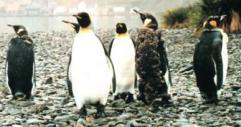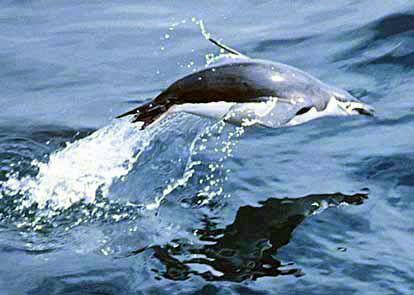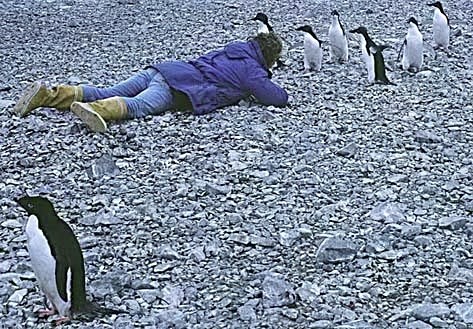This is an old revision of this page, as edited by Pengo (talk | contribs) at 11:47, 30 December 2003. The present address (URL) is a permanent link to this revision, which may differ significantly from the current revision.
Revision as of 11:47, 30 December 2003 by Pengo (talk | contribs)(diff) ← Previous revision | Latest revision (diff) | Newer revision → (diff)| Penguins | ||||||||||
|---|---|---|---|---|---|---|---|---|---|---|
 | ||||||||||
| Larger version | ||||||||||
| Scientific classification | ||||||||||
| ||||||||||
|
Penguins are an order of flightless birds living in the southern hemisphere. They are not, contrary to popular belief, only found in cold climates, such as Antarctica. Many species live as far north as the Galapagos Islands and will occasionally cross the equator while feeding. Most penguins live off krill, fish, squid, and other forms of sealife that they catch while swimming underwater.
The largest species is the Emperor Penguin: adults average about 1.1 meter tall and mass 30 or more kilograms. The smallest penguin species is the Little Blue Penguin (also known as the Fairy Penguin), which is typically 35 to 40 cm tall and 1 kilogram. Generally larger penguins retain heat better and thus inhabit colder regions, while smaller penguins are found in temperate or even tropical climates.
Penguins emerged in the Eocene era 40 million years ago. Birds like Palaeeudyptes from the Eocene, Pachydyptes from the Miocene and the now extinct Great Auks resembled modern penguins. The links between other bird orders and penguins are still unknown. A distant relationship between penguins and petrels is assumed, but not proved. Most fossil penguins known were large, but not larger than the modern Emperor Penguin. All lived in the southern hemisphere.
Anatomy
Penguins are superbly adapted to an aquatic life. Their wings have become flippers; useless for flight in the air, but in the water penguins are astonishingly agile. Within the smooth plumage a layer of air is preserved ensuring buoyancy. This is the reason a chain of air bubbles stretches behind a diving penguin. The air layer also helpt insulate the bird in the icy waters of the Antarctic. The plumage of penguins in tropical and temperate zones is much thinner.
All penguins have a white underside and a dark (mostly black) upperside. This is for camouflage. A predator looking up from below (such as a Killer Whale or a Leopard Seal) has difficulty distinguishing between a white penguin belly and the reflective water surface.
Diving penguins reach 6 to 12 km/h, though there are reports about velocities of 27 km/h (which are probably realistic in the case of precipitate flight). The small penguins don't usully dive deep. Their prey is caught near the surface, and most dives are only one or two minutes in duration. They can dive deep in case of need, however: the large Emperor Penguin has been recorded reaching a depth of 267 metres and staying down for 18 minutes.
On land, penguins are clumsy. They either waddle on their feet or slide on the belly across the snow. However, they can actually run as fast or faster than most humans. They slide on their stomachs, called "tobogganing", to conserve energy AND move relatively fast at the same time.
Penguins have an excellent sense of hearing. Their eyes are adapted for vision under water, and are their primary means of locating prey. In air they don't see well, and in this environment penguins are near-sighted. Their sense of smell has not been researched so far.
Classification
All penguins belong to one order (Sphenisciformes) and one family (Spheniscidae).

Chinstrap Penguin hunting for krill.
- ORDER SPHENISCIFORMES
- Family Spheniscidae
- King Penguin, Aptenodytes patagonicus
- Emperor Penguin, Aptenodytes forsteri
- Gentoo Penguin, Pygoscelis papua
- Adelie Penguin, Pygoscelis adeliae
- Chinstrap Penguin, Pygoscelis antarctica
- Rockhopper Penguin, Eudyptes chrysocome
- Fiordland Penguin, Eudyptes pachyrhynchus
- Snares Penguin, Eudyptes robustus
- Erect-crested Penguin, Eudyptes sclateri
- Macaroni Penguin, Eudyptes chrysolophus
- Yellow-eyed Penguin, Megadyptes antipodes
- Little Penguin, Eudyptula minor
- African Penguin, Spheniscus demersus
- Magellanic Penguin, Spheniscus magellanicus
- Humboldt Penguin, Spheniscus humboldti
- Galapagos Penguin, Spheniscus mendiculus
Name
The name penguin was originally applied to another bird, the Great Auk, formerly found in Newfoundland and on other islands off the Canadian coast, but now extinct. Indeed the auks look somewhat like penguins, and occupy a similar environmental niche in the Northern Hemisphere, but are not related. Penguin is thought by some to derive from the Welsh words pen (head) and gwyn (white), applied to the Great Auk, which had a conspicuous white patch between the bill and the eye (although its head was black), or from an island off Newfoundland known as "White Head". According to another theory, the original name was pen-wing, with reference to the rudimentary wings of both Great Auks and penguins. A third (not widely accepted) theory is that penguin comes from the Latin pinguis (fat).
Notable Penguins Characters in Computing
The Linux logo/mascot Tux is a penguin. Sega's 1982 video-game Pengo stars a penguin. Penguins are featured in the computer game Pingus, similar to the classic computer game Lemmings.
Penguins in film
Wallace & Gromit: The Wrong Trousers features a ruthless criminal penguin (animated). Also the protagonist of the dialogue-less Swiss animation Pingu that has been running since 1982.

Adelie penguin in Antarctica.
Other meanings:
A British publisher - see Penguin Books
A supervillain who is encountered in the Batman comic books.
A missile, see Penguin missile.
A Feynman diagram, e.g. http://feyndiagram.com/examples/penguin.php